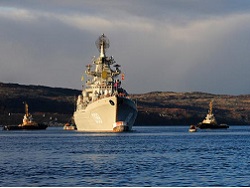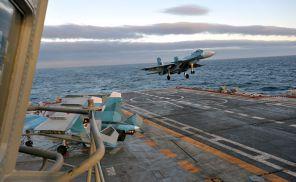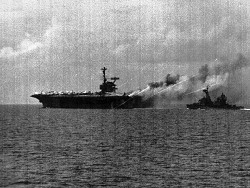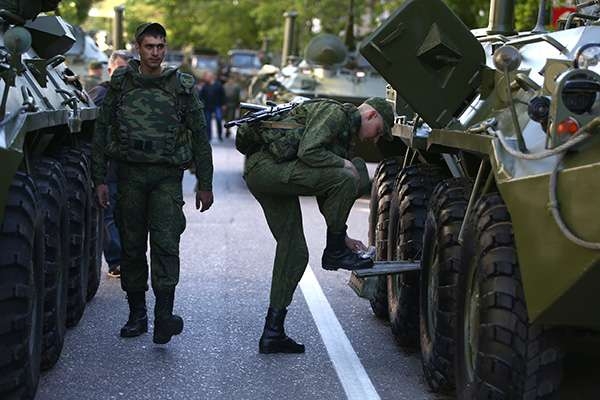
Ships and NATO aircraft can deduce the Federation Council of Russia from the game
Intensifies the struggle for redistribution of spheres of influence in the Arctic region. This is determined by a number of factors, most important of which are economic and military-strategic. Among the economic factors we can mention the discovery at the bottom of the Arctic ocean and its seas deposits of mineral resources, not only energy, but also other, in particular, ores of precious metals. Another important economic factor is communication — the Northern sea route is the shortest route connecting Europe and Asia. The control of this communication gives a huge economic and geopolitical benefits.
From the military strategic point of view, the Arctic region is interesting because it is the shortest trajectory of flight of strategic bombers and ICBM from Russia to USA and back. Also here are the most convenient areas of combat patrols of submarines, multi-purpose with strategic cruise missiles, and armed with ballistic missiles of sea basing. This means that the Arctic is an important strategic base for Russia and for USA.
That is why the struggle for control over this region today is becoming fiercer, turning in some cases to the use of military force, while in the form of demonstrations and exercises, but very meaningful. In this regard, we can predict that the development of global crisis with the intensification of the struggle for resources may lead to the emergence in the region of armed conflict or even war. With the exception of Russia, all the countries bordering the Arctic area, and are members of NATO or friendly to the unit configured. It is therefore understood that a possible conflict for the redivision of spheres of influence in the region can only be between Russia and a coalition of other countries of the Arctic basin at the head of the United States.
Nuclear potential of Russia will limit the scale of such a war (conflict) within the nuclear threshold. Therefore, we must assume that the main purpose of this conflict (war) may be the redistribution of spheres of influence with a capture under control of the disputed Islands and their communities. In this regard, the main content of a possible war in the Arctic region will be the confrontation of fleets — from Russia SF, and from its opponents — the NATO naval forces in the Atlantic area.
At the end of 2015 (according to open sources) as part of SF has 43 submarines and 41 surface ship. Aviation of the Northern fleet consists of 57 aircraft and 62 helicopters for various purposes.
The basis of submarine forces Northern fleet is 9 missile submarines of strategic purpose, 3 missile submarines with cruise missiles etc. 949А, 14 multipurpose nuclear submarines and 7 non-nuclear (diesel-electric).
The basis of the surface forces of the Northern fleet consists of 1 heavy aircraft carrying cruiser (in fact, the average aircraft carrier) “Admiral Kuznetsov” Ave 11435, 2 heavy nuclear-powered missile cruiser PR. 11442, (“Admiral Nakhimov” and “Peter the Great”), 1 missile cruiser PR. 1164 (“Marshal Ustinov”), 5 large anti-submarine ships of project 1155, 2 destroyers PR. 956, 3 small missile ship of project 12341 and 12347, 6 small anti-submarine ships PR. 1124 M 3 and 7 the basic marine and inshore minesweepers, and 4 large landing ship PR. 775.

Missile cruiser “Marshal Ustinov” (Photo: Aleksandr Chumichev and Alexander Sentsov/ TASS)
The basis of the aircraft fleet of naval aviation of the Northern fleet consists of 12 shipborne fighters su-33 and 14 MiG-29K/KUB, 5 distant reconnaissance aircraft Tu-22MR, 3 long-range antisubmarine aircraft Tu-142М, 10 anti-submarine Il-38 aircraft and 4-relay Tu-142МР.
Helicopters naval aviation of the Northern fleet represented 20 ship anti-submarine helicopters Ka-27ПЛ, 2 radar picket helicopters Ka-31, 16 transport-combat helicopters Ka-29 and 24 multi-purpose helicopters Mi-8.
According to military experts, from 30 to 50% of the ship’s structure in need of repair (current, average, or small caps), therefore for solving problems of unfit or partially fit. A significant part of aircraft and helicopters aviation of the Northern fleet are unsuitable for flight condition and is in need of restorative repair.
With the beginning of the war the Northern fleet will begin to interact with the 21st air defense corps, which in the common air defense system will cover bases, bases and naval forces in his area of responsibility (in its composition has two regiments of fighter aircraft to 60 aircraft, of which can be from 20 to 40 serviceable, and 3 anti-aircraft missile regiment of S-300П).
For the decision of problems of struggle against large surface groups of a potential enemy, the Northern fleet can be supported by Long-range aviation forces which may be allocated for this had been part of the aviation fleet of aircraft Tu-22M3 in an amount up to 20 units.
Northern fleet (including the partial commissioning of the ships, submarines, aircraft and helicopters requiring repair) can form:
— the grouping strike forces to combat surface groups of the opponent in the far sea zone, the maximum composition of which is: heavy aircraft carrying cruiser (12-18 operable su-33 and 16-18 serviceable Ka-27ПЛ in the composition of the air group), 1-2 missile cruisers, 2-3 big anti-submarine ships, 1-2 destroyers, 1-2 missile submarines with cruise missiles and up to 2 multi-purpose nuclear submarines with 15-20 supporting the Long range aircraft Tu-22M3.
group antisubmarine forces near sea area, including up to 2 ship search and attack groups, up to 4-5 conventional submarines and 6-8 anti-submarine aircraft.
To combat enemy surface forces in the near Maritime zone of the Northern fleet will be able to form no more than one naval strike group composed of 2-3 small missile ships.
Assistance to Maritime flank of the army of Northern fleet will be able to be carried by 3-4 amphibious ships with naval infantry battalion aboard.

Su-33 landing aboard the aircraft carrier Admiral Kuznetsov in the Barents sea (Photo: Lev Fedoseyev/ TASS)
These forces are quite enough to ensure the protection of interests of Russia in the Arctic ocean and adjacent seas in attempt to redistribute power through the exclusive economic zones of regional powers, such as Norway. But they will not act independently. To force the redistribution of spheres of influence in the Arctic (if it comes to that) will connect the NATO led by the USA, which put up against our SF 2-3 carrier strike groups, 2-3 naval strike group and up to 12-15 nuclear submarines (most of which can be deployed in the Barents sea). These forces are supported by tactical aircraft from airfields in Northern Norway in the amount (taking into account the operational capacity of the airfield network) 50% or more of the machines.
To capture certain Islands in the grouping of NATO naval forces can be present landing party consisting of 10-15 ships with an expeditionary brigade of naval infantry on Board.
The assessment of the likely progress of the fighting shows that the existing forces SF will be able in the most favorable conditions to weaken the carrier compound of the U.S. Navy (taking out one of 2-3 aircraft carrier of the U.S. Navy and sunk 2-3 surface ship escort) and destroy 2-3 nuclear submarines of the USA in the Barents sea. That is the task of the defeat of surface and submarine naval groups of the enemy will not be solved. While the majority of ships and aircraft impact and anti-submarine groups of the Northern fleet will be destroyed.
Can’t the Northern fleet and solve the key task of ensuring the combat stability of missile submarines of strategic purpose. Existing anti-submarine forces allow you to control only a small part of the patrolling missile submarines of strategic purpose and waters adjacent to the areas of basing of naval forces in the Barents sea.
Central forces will not be able to effectively deal with mine-even in the area of naval bases.
The loss of SF can be from 30-40% to 50-60% of tonnage and coastal infrastructure marine and aviation, which would effectively mean the loss of strategic value. However, he will not address any significant operational mandates due to obvious lack of power. After this, the enemy will be able without interference to solve the problems of the island capture zones, displacing Russia from the region of the Arctic ocean, to strike the sea with directions to the Armed Forces and the economy of our country.
In this regard, it is necessary to take emergency measures to rebuild the capacity of SF to a level at which he will be able successfully to resist the fleet of NATO and the United States, at least in the Arctic region. As long as the potential SF has not been restored, it is necessary to adopt a package of diplomatic measures to prevent any possibility of waging war against Russia. The most important of these is a clear statement about the readiness of the transition to the use of nuclear weapons after it reaches a certain level the combat potential of the Russian army grouping in the Arctic zone, in particular, the Federation Council, captured by the enemy, certain Islands or island areas, destroying at least one of the PKK CH (missile submarine strategic purpose).








